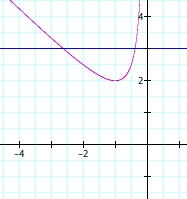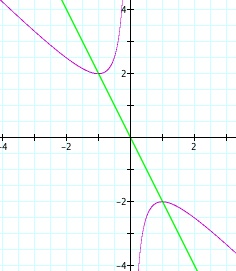

Varying the Coefficient of x in a Quadratic
by
Stacy Musgrave
We're first going to consider the equation x2 + bx + 1 = 0 in the xb-plane.
Now if we then graph any horizontal line b=d, the x-coordinate of the point(s) of intersection, if they exist, will represent the x-intercepts of the quadratic x2 + dx + 1. We clearly observe that such a quadratic will have two x-intercepts for b > 2 and b< -2, one x-intercept for b = 2 or -2 and NO x-intercepts for -2 < b <2. Such an example can be seen if we graph b = 3. At left is the graph in the xb-plane, clearly showing two points of intersection. At right is the quadratic formula showing the two solutions for finding the roots of the quadratic y = x2 + 3x + 1.

Likewise, if we let b = 1, we see there is no point of intersection in the xb-plane and the quadratic formula indeed shows us there are no real solutions to the equation 0 = x2 + x +1.
Now, let's change our c-value so that we're looking at x2 + bx - 1 = 0. Since the discriminant for the quadratic y = x2 + bx - 1 is always positive (D = b2 - 4(1)(-1) = b2 + 4 > 0 for any real number b), we get two real roots for this quadratic. So we expect when we graph in the xb-plane, and draw any horizontal line, we should see exactly two points of intersection. This is, in fact, the case.
Finally, we explore the graph of 2x + b = 0 in relation to the above mentioned quadratics.

In both graphs, we observe that if we fix a b value, the intersection of 2x + b = 0 with this horizontal line will be an equal distance to each of the intersections of the horizontal line with the original quadratic. This makes sense with what we know about parabolas, since x = -b/2 is the x-coordinate of the vertex of the parabola x2 + bx + c for any c. Because parabolas are symmetric about the vertical line through the vertex, the x-intercepts should be an equal distance horizontally from this line.
Return to homepage